By Lawrence W. Sherman
Police are often criticized fordoing “too much” or “too little” policing in various sit-uations. These criticisms amount to testable hypothe-ses about whether “less” force, or intensity, or enforce-ment would have been enough, or whether “more” was needed. The rise of evidence-based policing provides a starting point for public dialogues about those hypotheses, in ways that could help to build police legitimacy.Such dialogues can be focused on the questions posed by the three “Ts”: (1) Is police actiontargetedin a way that is proportionate to the harm that it can prevent?(2) Has the action been tested and found effective with the kinds of targets, and their levels of harm, where it is being used? (3) Is police actiontrack to ensure it is delivered in the way that has been tested, and in compli-ance with relevant legal requirements? In this lecture, I frame the issue as follows:Can more widespread use of better research evidence on targeting, testing, and tracking police actions, shared more clearly among the public and police, help reduce the wide range of oscillation between over-policing and under-policing?PolicyImplications:Theuseofthesequestionsinpub-lic dialogue would be especially relevant to the three biggest threats to police legitimacy in the aftermath ofGeorge Floyd’s murder: (A) police killing people, (B)police stopping people, and (C) police under-patrolling 176SHERMANhigh-crime hot spots (while over-patrolling low-crime areas). One result of applying the three-Ts questions to these threats, for example, could be the end of the vast overuse of stop and search in low-violence areas. At The same time, this approach could also lead to reduc-tions in homicide by increasing stops in highest vio-lence hot spots. Such changes could demonstrate how the “Goldilocks principle” for the three Ts could get policing closer to “just right” for each place and person being policed.
Criminology & Public Policy.2022;21:175–196





















